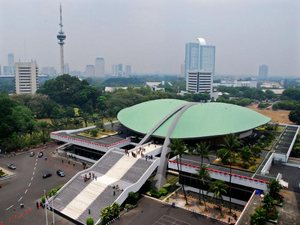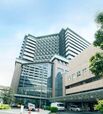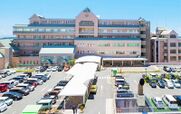Mikochi: Difference between revisions
(Adding some images) |
mNo edit summary |
||
| Line 197: | Line 197: | ||
}} | }} | ||
=== Government === | |||
'''Politics''' | |||
Mikochi has a democratic government, a unitary state and a constitutional republic with a parliamentary system. The Prime Minister is head of state and head of government, and is the commander-in-chief of the armed forces. The Prime minister is elected through direct election by the citizens of Mikochi for a six-year term. The Prime Minister appoints and presides over the Ministries of Mikochi, which in turn run various national government agencies and institutions. The bicameral parliament is composed of the House of Seniors (The upper house, with members elected to a six-year term) and the House of Juniors (the lower house, with members elected to a three-year term). | |||
'''Foreign Relations''' | '''Foreign Relations''' | ||
| Line 216: | Line 219: | ||
! colspan="3" |Ministry Name | ! colspan="3" |Ministry Name | ||
! rowspan="2" |Minister | ! rowspan="2" |Minister | ||
|- | |- | ||
!Anglish | !Anglish | ||
| Line 227: | Line 228: | ||
|Sōmu-shō | |Sōmu-shō | ||
|Sato Haruto | |Sato Haruto | ||
|- | |- | ||
|Ministry of Justice | |Ministry of Justice | ||
| Line 241: | Line 233: | ||
|Hōmu-shō | |Hōmu-shō | ||
|Takahashi Yuki | |Takahashi Yuki | ||
|- | |- | ||
|Ministry of External Affairs | |Ministry of External Affairs | ||
| Line 253: | Line 238: | ||
|Gaikō-shō | |Gaikō-shō | ||
|Ito Mio | |Ito Mio | ||
|- | |- | ||
|Ministry of Finance | |Ministry of Finance | ||
| Line 260: | Line 243: | ||
|Zaimu-shō | |Zaimu-shō | ||
|Yamaguchi Mei | |Yamaguchi Mei | ||
|- | |- | ||
|Ministry of Education, Culture, Sports, Science and Technology | |Ministry of Education, Culture, Sports, Science and Technology | ||
| Line 270: | Line 248: | ||
|Monbu-kagaku-shō | |Monbu-kagaku-shō | ||
|Sasaki Tsubasa | |Sasaki Tsubasa | ||
|- | |- | ||
|Ministry of Health, Labour and Welfare | |Ministry of Health, Labour and Welfare | ||
| Line 282: | Line 253: | ||
|Kōsei-rōdō-shō | |Kōsei-rōdō-shō | ||
|Matsumoto Rina | |Matsumoto Rina | ||
|- | |- | ||
|Ministry of Agriculture, Forestry and Fisheries | |Ministry of Agriculture, Forestry and Fisheries | ||
| Line 294: | Line 258: | ||
|Nōrin-suisan-shō | |Nōrin-suisan-shō | ||
|Inoue Shota | |Inoue Shota | ||
|- | |- | ||
|Ministry of Economy, Trade and Industry | |Ministry of Economy, Trade and Industry | ||
| Line 304: | Line 263: | ||
|Keizai-sangyō-shō | |Keizai-sangyō-shō | ||
|Yamazaki Ryo | |Yamazaki Ryo | ||
|- | |- | ||
|Ministry of Land, Infrastructure, Transport and Tourism | |Ministry of Land, Infrastructure, Transport and Tourism | ||
| Line 314: | Line 268: | ||
|Kokudo-kōtsū-shō | |Kokudo-kōtsū-shō | ||
|Ikeda Asahi | |Ikeda Asahi | ||
|- | |- | ||
|Ministry of Environment | |Ministry of Environment | ||
| Line 326: | Line 273: | ||
|Kankyō-shō | |Kankyō-shō | ||
|Fujita Ayaka | |Fujita Ayaka | ||
|- | |- | ||
|Ministry of Defense | |Ministry of Defense | ||
| Line 334: | Line 278: | ||
|Bōei-shō | |Bōei-shō | ||
|Mori Saki | |Mori Saki | ||
|- | |- | ||
|Ministry of Digitisation | |Ministry of Digitisation | ||
| Line 341: | Line 283: | ||
|Dejitaru-chō | |Dejitaru-chō | ||
|Nakajima Yui | |Nakajima Yui | ||
|- | |- | ||
|Ministry of Reconstruction | |Ministry of Reconstruction | ||
| Line 349: | Line 288: | ||
|Fukkō-chō | |Fukkō-chō | ||
|Murakami Kaede | |Murakami Kaede | ||
|- | |- | ||
|Ministry of the Cabinet Office | |Ministry of the Cabinet Office | ||
| Line 356: | Line 293: | ||
|Naikaku-fu | |Naikaku-fu | ||
|Hasegawa Toma | |Hasegawa Toma | ||
|} | |} | ||
| Line 620: | Line 553: | ||
=== Human Rights === | === Human Rights === | ||
Mikochi has a high | Mikochi has a high | ||
== Demographics == | == Demographics == | ||
| Line 667: | Line 560: | ||
=== Religion === | === Religion === | ||
Although Mikochi is a secular state with freedom of religion, and overwhelming majority of citizens consider religion very important and atheism is low. Kamidōism is by far the dominant religion, followed by about 76 percent of the population. | |||
Phosattistism is the country's second-largest religion, with 18 percent of the population in the 2022 census. Most Phosattists live in Seinan, close to the Sheng homelands. | |||
'''Kamidōism''' | '''Kamidōism''' | ||
. | |||
'''Phosattism''' | '''Phosattism''' | ||
| Line 679: | Line 574: | ||
=== Education === | === Education === | ||
Compulsary education in Mikochi comprises elementary and junior high school, which together last for nine years. The majority of children continue their education at a three-year senior high school, however apprenticeships have been on the rise in recent years. The top-ranking university in the country is the Metropolitan University of Umikyo. | |||
Mikochi spends roughly 5.8% of it's total GDP on education and training as of 2024. | |||
=== Health === | === Health === | ||
| Line 706: | Line 603: | ||
Funding for the MNHS comes from a mix of general taxation and mandatory health insurance contributions from both employers and employees, ensuring financial stability while maintaining accessibility. The MNHS also collaborates with private healthcare providers, giving patients the option to choose between public and private care. | Funding for the MNHS comes from a mix of general taxation and mandatory health insurance contributions from both employers and employees, ensuring financial stability while maintaining accessibility. The MNHS also collaborates with private healthcare providers, giving patients the option to choose between public and private care. | ||
== Economy == | |||
(WIP. Employment. Exports and imports. International partners. Currency. Energy. Transportation. Science & technology. Unemployment numbers. Tourism. Media.) | |||
'''Agriculture and aquaculture''' | |||
fishing? farming? rice? | |||
'''Industry and services''' | |||
cars? shipbuilding? steelworking? | |||
'''Science and technology''' | |||
fff | |||
'''Tourism''' | |||
popular areas, tourism policies | |||
== Infrastructure == | |||
'''Transportation''' | |||
Umikyo - the metro | |||
airports | |||
The primary form of transport across Mikochi's various island is via ferries. Ferries are partially subsidised by the Mikochi government, allowing for cheap travel across the country. | |||
'''Energy''' | |||
Nuclear plant in Akahama???? | |||
Offshore wind, solar farms. | |||
'''Water''' | |||
water supply? clean water? sewage? | |||
== Culture == | == Culture == | ||
Revision as of 11:36, 15 August 2024
Mikochi | |
|---|---|
| Map of Mikochi Map of Mikochi | |
| Capital | Umikyo |
| Largest | Greater Umikyo |
| Official languages | Mikochinese |
| Religion | Kamidōism (神道) |
| Demonym(s) | Mikochin |
| Government | Parliamentary Republic |
| Legislature | National Parliament |
| House of Seniors | |
| House of Juniors | |
| Establishment | |
• Independence from Sheng Dynasty | 433 |
• Ratification of People's Constitution | 11/04/1986 |
| Area | |
• | 76,017 km2 (29,350 sq mi)Excluding Water |
| Population | |
• 2023 census | 32,312,394 |
• Density | 425/km2 (1,100.7/sq mi) |
| GDP (nominal) | estimate |
• Total | 549,989,258,274 |
• Per capita | 17,021 |
| Gini (2023) | 35 medium |
| HDI | high |
| Time zone | UTC-8 |
| Date format | dd/mm/yyyy |
| Driving side | left |
| Internet TLD | .mk |
Mikochi (Azumic: 海越地), officially known as the Democratic People's Republic of Mikochi, is an island country mainly located within the Lotus Sea in north-west Aurelia, with a smaller territory off the coast of Alharu. Mikochi sits south of Esonice and shared a maritime border with Goankok to the west. Mikochi has a land area of approximately 76,017km² and a population of 32.3 million, mainly spread out across it's 6 largest islands.
Mikochi's largest city and capital, Umikyo, is home to 8.2 million residents, and is located within the Umikyo Special Economic Area, which has assisted in the diversification of the Mikochi economy,
(paragraph on history)
(paragraph on demographic/culture/religion)
(paragraph on government/IR)
Since the end of the Second Mikochi Civil War, the gross domestic product (GDP) of Mikochi has seen yearly growth for almost 40 years, which currently sits at $549,989,258,274. Mikochi's economy has traditionally been driven by primary sector goods, however Mikochi has started to transition into the secondary and tertiary sectors, such as commerce, tourism and manufacturing . Mikochi is a newly industrialised mixed economy, with a high ranking Human Development Index and very high Gini coefficient. Mikochi's primary exports are automobiles, consumer goods and fish.
Etymology
The name for Mikochi comes from the Sheng dynasty, who dubbed the island Kò-hái ê tē (過海地), roughly translating to Land Across the Sea in the Sheng Language.
As the Azumic language began to adopt Sheng characters, the Sheng name for the island was translated as Umi-koe no Chi (海越えの地). Throughout time, the name would simplify to Mikochi (海越地).
Throughout most of the 19th and 20th century, Mikochi was known internationally as the Lotus Kingdom and later the Lotus Republic, the name being taken from the sea in which Mikochi is located. Following the Second Mikochi Civil War, the new government made an appeal to the international community to standardise the name in all languages as Mikochi.
Geography
(WIP. Landscape. Climate. Where exactly is your country compared to others on the global map? Describe the landscape, plants, and animals. Which mountains and rivers are important to include? Describe are the climate and seasons? How does geography determine where people live? Are there areas separated from one another? How about cities? This will greatly help you with the next part of history.)
Climate
Cities
Umikyo Special Economic Area
The largest city in Mikochi is it's capital, Umikyo. Umikyo forms the centre of the Umikyo Special Economic Area (USEA), along with Shiokaze, Kaiyomachi and Gyoen. The USEA is broken up into a series of special wards. The USEA was created in 2018 by Prime Minister Kurogane Kenshin to attract foreign investment into the city, by implementing special economic and immigration policies for the city. The USEA is served by the Umikyo Metropolitan Police (UMP), which is broken up into departments for each Special Ward.
Urbanisation
Mikochi's high population density has led to rapid urbanisation, with over 70% of the country's citizens living in large towns and cities.
Largest cities or towns in Mikochi
2023 census | |||||||||
|---|---|---|---|---|---|---|---|---|---|
| Rank | Prefecture | Pop. | |||||||
 ]] ]][[Umikyo]]  Shiokaze |
1 | [[Umikyo]] | Umikyo | 0 |  Sakurazaki  Kagayaki | ||||
| 2 | Shiokaze | Shiokaze | 0 | ||||||
| 3 | Sakurazaki | Sakurazaki | 0 | ||||||
| 4 | Kagayaki | Seikatsuhama | 0 | ||||||
| 5 | Kaiyomachi | Kaiyo | 0 | ||||||
| 6 | Gyoen | Hanasui | 0 | ||||||
| 7 | Akahama City | Akahama | 0 | ||||||
| 8 | Kinko | Takarajima | 0 | ||||||
| 9 | Kita | Kitagishi | 0 | ||||||
| 10 | Ishishi | Ishigaki | 0 | ||||||
History
Main Article: History of Mikochi
[Pg Early History]
[Pg Medieval History]
[Pg Modern History]
Politics
Government
Politics
Mikochi has a democratic government, a unitary state and a constitutional republic with a parliamentary system. The Prime Minister is head of state and head of government, and is the commander-in-chief of the armed forces. The Prime minister is elected through direct election by the citizens of Mikochi for a six-year term. The Prime Minister appoints and presides over the Ministries of Mikochi, which in turn run various national government agencies and institutions. The bicameral parliament is composed of the House of Seniors (The upper house, with members elected to a six-year term) and the House of Juniors (the lower house, with members elected to a three-year term).
Foreign Relations
Main Article: Foreign Relations of Mikochi
Mikochi maintains positive relations with most of the wurld, and actively seeks cooperation with other nations. Mikochi maintains an active mission to the Associated Nations, and often supports resolving environmental and humanitarian issues. Mikochi is also a member of the Aurelian League since 1986, and a member of the ASC.
Mikochi transitioned into a XXXX in 1980 following the conclusion of the Second Civil War. Currently, the government is lead by a coalition of the SDP and Ruralist party.
Ministries
The Government of Mikochi is broken into Ministries to subdivide responsibilities and agencies. Each ministry is headed by a minister, which is selected by the Prime Minister.
| Ministry Name | Minister | ||
|---|---|---|---|
| Anglish | Kanji | Aromaji | |
| Ministry of Internal Affairs and Communications | 総務省 | Sōmu-shō | Sato Haruto |
| Ministry of Justice | 法務省 | Hōmu-shō | Takahashi Yuki |
| Ministry of External Affairs | 外交省 | Gaikō-shō | Ito Mio |
| Ministry of Finance | 財務省 | Zaimu-shō | Yamaguchi Mei |
| Ministry of Education, Culture, Sports, Science and Technology | 文部科学省 | Monbu-kagaku-shō | Sasaki Tsubasa |
| Ministry of Health, Labour and Welfare | 厚生労働省 | Kōsei-rōdō-shō | Matsumoto Rina |
| Ministry of Agriculture, Forestry and Fisheries | 農林水産省 | Nōrin-suisan-shō | Inoue Shota |
| Ministry of Economy, Trade and Industry | 経済産業省 | Keizai-sangyō-shō | Yamazaki Ryo |
| Ministry of Land, Infrastructure, Transport and Tourism | 国土交通省 | Kokudo-kōtsū-shō | Ikeda Asahi |
| Ministry of Environment | 環境省 | Kankyō-shō | Fujita Ayaka |
| Ministry of Defense | 防衛省 | Bōei-shō | Mori Saki |
| Ministry of Digitisation | デジタル庁 | Dejitaru-chō | Nakajima Yui |
| Ministry of Reconstruction | 復興庁 | Fukkō-chō | Murakami Kaede |
| Ministry of the Cabinet Office | 内閣府 | Naikaku-fu | Hasegawa Toma |
Administrative divisions
Mikochi is divided into [number] of prefectures, each overseen by an elected govenor and legislature. (i think this is outdated)
| ISO | Prefecture | Kanji | Meaning | Prefecture Capital | Population | Area | Population Density |
|---|---|---|---|---|---|---|---|
| MK-01 | Akahama | 赤浜県 | Red Beach | Akahama-shi | |||
| MK-02 | Hanasui | 花水県 | Flower Water | Ryugu | |||
| MK-03 | Hinohama | 陽浜県 | Sun Beach | Namiura | |||
| MK-04 | Kaiyo | 海陽府 | Ocean Sun | Kaiyomachi | |||
| MK-05 | Midorinoumi | 緑の海県 | Green Sea | Asahimura | |||
| MK-06 | Shiokaze | 潮風府 | Sea Breeze | Shiokaze | |||
| MK-07 | Umikyo | 海京都 | Sea Capital | Umikyo | |||
| MK-08 | Aozorashima | 青空島県 | Blue Sky Island | ||||
| MK-09 | Hinayama | 日向山県 | Sunny Mountain | ||||
| MK-10 | Ishigaki | 石垣県 | Stone Wall | ||||
| MK-11 | Kazetani | 風谷県 | Wind Valley | ||||
| MK-12 | Kitagishi | 北岸県 | North Coast | ||||
| MK-13 | Sakurazaki | 桜崎県 | Sakura Cape | ||||
| MK-14 | Seikatsuhama | 生活浜県 | Life Beach | ||||
| MK-15 | Kaiyushima | 回遊島県 | Wandering Island | ||||
| MK-16 | Nijinoshima | 虹の島県 | Rainbow Island | ||||
| MK-17 | Takarajima | 宝島府 | Treasure Island |
There are 3 different types of prefectures in Mikochi, variying with the urbanisation of the prefecture. (this isn't!)
| Type | Hangen | Romaji | No. | |
|---|---|---|---|---|
| Metropolis | 都 | to | 1 | Umikyo (海京都 Umikyo-to) |
| Urban Prefecture | 府 | fu | 4 | Takarajima Prefecture (宝島府 Takarajima-fu), Shiokaze Prefecture (潮風府 Shiokaze-fu) and Kaiyo Prefecture (海陽府 Kaiyo-fu) |
| Prefecture | 県 | ken | 12 |
Military
Mikochi's military is the Mikochi Defense Force (MDF), and comprises 3 branches covering Sea, Air and Land. The MDF was created following the implementation of the 1986 constitution, and was a reformed version of the revolutionary forces that won the civil war 6 years prior. The MDF was outlined as a force to protect peace and not one to instigate violence.
Much of the HDF was restructured in 2012, following the reelection of Chancellor XX, XX. The MDF's funding was doubled, with the implementation of the '12-year plan' put in place to triple the strength of the MDF.
Mikochi Coastal Defence Force
The Mikochi Coastal Defence Force (CDF) is a vital branch of Mikochi's armed services, primarily responsible for ensuring maritime safety, security, and environmental protection within the nation's territorial waters and exclusive economic zones. The CDF operates a diverse fleet of vessels, including patrol boats, surveillance vessels, and specialized firefighting and hydrographic survey ships. With its headquarters in Shiokaze, the CDF is also involved in search and rescue operations, maritime law enforcement, and disaster response, effectively safeguarding the maritime interests and coastal communities of Mikochi.
Mikochi Air Guard
The Mikochi Air Guard (MAG) serves as the aerial defense wing of Mikochi, tasked with protecting the nation’s airspace and supporting ground operations. The MAG operates a fleet of fighter jets, transport aircraft, and drones, equipped to handle a range of missions from air combat and surveillance to disaster relief and international aid. Based out of various strategic air bases across the country, the MAG is committed to maintaining aerial sovereignty, providing rapid response capabilities, and engaging in multinational exercises to enhance global peace and security.
Mikochi Ground Defence Force
The Mikochi Ground Defence Force (GDF) is the principal land warfare force of Mikochi, dedicated to national defense and emergency response. Comprising several infantry, armored, and artillery units, the MNG is equipped to engage in a wide array of military operations both domestically and internationally. The Guard conducts regular training exercises to maintain high readiness levels and works closely with other national defense forces to ensure the security and stability of Mikochi. Additionally, the MNG plays a critical role in disaster response, aiding in recovery efforts during natural calamities and supporting civil authorities in maintaining law and order.
Imperial Military
Before its surrender and defeat in 1980, Mikochi's military comprised of the Imperial Army and Grand Fleet. These two forces were directly controlled by Mikochi's Tenno, and their creations date back to the Hakkei Dynasty in the 16th century.
War Participation
Mikochi has participated in multiple significant wars, including the Anglian invasion of Aurelia, and the First and Second Aurelian Wars.
Law Enforcement
Law enforcement overview? basic laws? freedoms?
| Regulation | Age | Notes |
|---|---|---|
| Consumption of Alchohol | 15 | As advised by the MNHS and with permission from a legal Guardian. |
| Purchase of Alchohol | 18 | |
| Driving | 17 | Mikochi Citizens may start lessons at 16 years and 6 months of age. |
| Voting | 16 | |
| Marriage | 18 | |
| Working | 16 | Mikochi Citizens between 14 - 16 may work no more than 12 hours per week. |
| Gambling | 21 | Citizens may be banned from Gambling by the HNHS |
Human Rights
Mikochi has a high
Demographics
(WIP. Demographics. Ethnic groups. Social classes. Language. Education. Marriage. Religion. Healthcare. Diseases.)
Religion
Although Mikochi is a secular state with freedom of religion, and overwhelming majority of citizens consider religion very important and atheism is low. Kamidōism is by far the dominant religion, followed by about 76 percent of the population.
Phosattistism is the country's second-largest religion, with 18 percent of the population in the 2022 census. Most Phosattists live in Seinan, close to the Sheng homelands. Kamidōism
. Phosattism
Phosattism was brought to Mikochi under the Sheng in the early 1st century. Whilst the majority of Mikochi is either a believer of Kamidōism or atheist, Phosattist sects still exist within the country. Mikochi to this date has some of the oldest Phosattist structures in the world, such as the XXX in XXX.
Languages
Hangen!
Education
Compulsary education in Mikochi comprises elementary and junior high school, which together last for nine years. The majority of children continue their education at a three-year senior high school, however apprenticeships have been on the rise in recent years. The top-ranking university in the country is the Metropolitan University of Umikyo.
Mikochi spends roughly 5.8% of it's total GDP on education and training as of 2024.
Health
mortality, birth rates, diseases, access to health?
Mikochi National Health Service (HNHS)
The Mikochi National Health Service (MNHS) is the cornerstone of Mikochi's healthcare system, providing essential medical services to its citizens. Established in 1984, the MNHS was designed to ensure that all residents have access to fundamental healthcare, regardless of their socioeconomic status. The system operates on a hybrid model, offering a blend of free and subsidized services to balance accessibility with sustainability.
Basic services such as community specialists (CS) visits and emergency care are free at the point of use, funded through a combination of government allocations and a national health insurance scheme. For more specialized treatments, patients may be required to pay a subsidized fee, determined by their income level and the type of service required.
The MNHS emphasizes community health, operating numerous centers across Mikochi, particularly in rural areas, ensuring that even remote populations have access to essential services. Mental health is also a priority, with dedicated facilities providing comprehensive care. Recent years have seen the introduction of telehealth services, further expanding the reach of the MNHS.
Funding for the MNHS comes from a mix of general taxation and mandatory health insurance contributions from both employers and employees, ensuring financial stability while maintaining accessibility. The MNHS also collaborates with private healthcare providers, giving patients the option to choose between public and private care.
Economy
(WIP. Employment. Exports and imports. International partners. Currency. Energy. Transportation. Science & technology. Unemployment numbers. Tourism. Media.)
Agriculture and aquaculture
fishing? farming? rice?
Industry and services
cars? shipbuilding? steelworking?
Science and technology
fff
Tourism
popular areas, tourism policies
Infrastructure
Transportation
Umikyo - the metro
airports
The primary form of transport across Mikochi's various island is via ferries. Ferries are partially subsidised by the Mikochi government, allowing for cheap travel across the country.
Energy
Nuclear plant in Akahama????
Offshore wind, solar farms.
Water
water supply? clean water? sewage?
Culture
(WIP. Cuisine. Literature. Visual arts. Art. Architecture. Entertainment. Music & Radio. Television. Cuisine. Local customs. Clothing. Morality. Sports. Stereotypes. Your national symbols such as the flag and national anthem. Public holidays and festivities.)
Contemporary Mikochi culture combines influences from other Azumic nations, Northern Aurelia and the Orient. Traditional Mikochi arts include crafts such as pottery, textiles, woodworking and swords; a unique music performance known as XXX; and other practices such as calligraphy, games and music.
Art and architecture
Paintings? statues? famous artists?
Literature and philosophy
poems? popular books? famous writers?
Music
popular instruments? famous singers/bands?
Performing Arts
musicals? some form of mime? famous playwrites?
Cuisine
food! famous chefs?
Media
anime? manga? films? magazines?
Sports
gaming? racing? association football? tennis? badminton? famous sportspeople?







